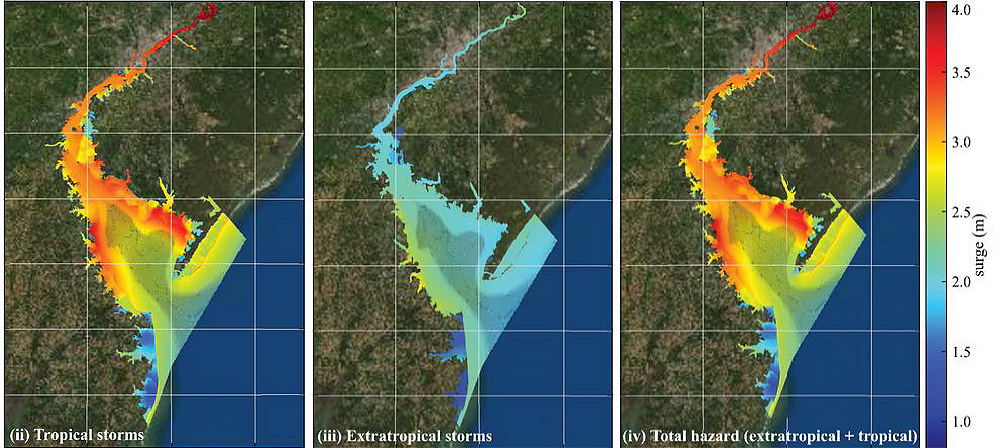During the period October 1, 2019 through September 30, 2021, a team of researchers including Rick Luettich, Brian Blanton, and Taylor Asher of UNC Chapel Hill; Alex Taflanidis, Andrew Kennedy, and Tracy Kijewski-Correa from the University of Notre Dame; Matthew Plumlee of Northwestern University; Elaine Spiller of Marquette University; and Lauren Schmied of the Federal Emergency Management Agency collaborated on the project, “Coastal Probabilistic Hazard Assessment” as described below.
Project Background
Significant advances in storm surge prediction over the past couple of decades have produced high-fidelity simulation models, such as ADCIRC, that provide detailed representations of hydrodynamic processes and high-accuracy prediction. However, the computational burden of such numerical models is large when run at high spatial resolution. This can limit their applicability for detailed risk assessment, which requires a large ensemble of storm scenarios, and for emergency response, which requires fast event-based predictions. At the same time, many FEMA coastal studies in the last decade have used models such as ADCIRC producing a vast amount of data that include time and spatially-varied simulated waves, water levels, wind, atmospheric pressure, and currents, among other variables. These data could be useful for other efforts if they were more easily discoverable and accessible (see Figure 1).
This data availability has motivated researchers to investigate the use of interpolation methodologies and surrogate models to provide fast storm-surge predictions with the goal of maintaining the accuracy of the numerical model used to produce the data, while providing greatly enhanced computational efficiency. Surrogate models provide a fast-to-compute mathematical approximation to the input/output relationship of a computationally expensive numerical model, leveraging a dataset of simulations from the numerical model (synthetic storms for the application examined here). Kriging, also referred to as Gaussian Process Metamodel (GPM), has been demonstrated in a number of studies to offer great versatility as a surrogate model in this context: it can provide high-accuracy predictions for both storm surge and waves and for either peak or time-series responses; it has been efficiently applied for datasets of different sizes and characteristics; and it has been used to provide predictions over large coastal regions.
Objective
The objective of this project is to extend and demonstrate the utility of GPMs to support the probabilistic estimation of coastal hazards, leveraging datasets from synthetic storm simulations made in support of recent FEMA coastal hazard studies.

Products & Results
Work conducted in this project used 156 ADCIRC tropical cyclone model runs completed in 2013 for a National Flood Insurance Program study for FEMA Region 3 to develop a surrogate model for the Delaware Bay region. Specific major tasks have included:
- Building a database of the original 156 ADCIRC Tropical Cyclone runs that can be queried conveniently by an interested user;
- Developing a strategy to compute pseudo-surge in areas of the domain that were not actually inundated for one or more storms to fully populate the 156 ADCIRC TC runs in all areas of the domain;
- Establishing the surrogate from the 156 ADCIRC runs, computing error metrics and evaluating best practices for input parameter definitions so as to achieve the greatest accuracy from the surrogate model;
- Developing a 40-year long storm surge hindcast for extratropical storms to be used to supplement the TC surrogate model to complete full hazard curves;
- Evaluating the surrogate model using an independent TC dataset computed by the US Army Corps of Engineers as part of the North Atlantic Coastal Comprehensive Study that included the Delaware Bay region;
- Transitioning the surrogate model and associated work flow to FEMA NFIP contractors for their evaluation as a tool for future NFIP studies.
Results from the initial three tasks were completed in Year 6 and mostly covered in:
Aikaterini P.K., A.A. Taflanidis, M. Plumlee, T.G. Asher, E. Spiller, R.A. Luettich Jr, B.O. Blanton, T.L. Kijewski-Correa, A. Kennedy, L. Schmied, “Improvements in storm surge surrogate modeling for synthetic storm parameterization, node condition classification and implementation to small size databases”, Natural Hazards, https://doi.org/10.1007/s11069-021-04881-9.
The final three tasks were completed during the first part of Year 7. Products delivered by the project included:
- A trained Tropical Cyclone surrogate model for the Delaware Bay area
- 41-year water level reanalysis for Delaware Bay area to capture extratropical storms. This will be expanded later to cover the entire Gulf / Atlantic coasts (NOAA)
- Tidal data base for Delaware Bay region to capture tidal contribution
- New hazard data for Delaware Bay region (see Figure 2)
- Surrogate models for significant wave height for Delaware Bay region

In addition to the delivered products, the project demonstrated that:
- A properly designed surrogate model is a highly effective and efficient methodology for reproducing Tropical Cyclone storm surge/inundation
- It is very important to train the surrogate model on a “representative” set of storms
- A 41-yr reanalysis database is significant for defining extratropical response
